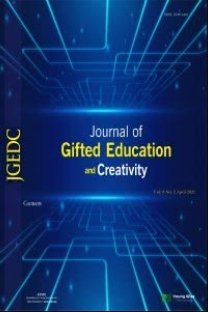Creative and Critical Thinking Skills in Problem-based Learning Environments
problem-based learning, creative thinking, critical thinking, instructional design
Creative and Critical Thinking Skills in Problem-based Learning Environments
___
- Albanese, M., & Mitchell, S. (1993). Problem-based learning: A review of the literature on its outcomes and implementation issues. Academic Medicine, 68, 52–81.
- Arslan, M. (2007). Ögretim ilke ve yöntemleri. Anı Publishing, Ankara.
- Augustine, N. R. (2011). Educating the gifted. Psychological Science in The Public Interest,12(1), 1-2
- Barrows, H. S., & Tamblyn, R. M. (1998). Problem-based learning: An approach tomedical education. New York: Springer.
- Batdı, V. (2014). The effects of a problem-based learning approach on students’attitude levels: A meta-analysis. Educational Research and Reviews, 9(9), 272-276. Bruner, J.S. (1961). The act of discovery. Harvard Educational Review, 31, 21-32.
- Choi, E., Lindquist, R., & Song, Y. (2014). Effects of problem-based learning vs.traditional lecture on Korean nursing students’ critical thinking, problem-solving, and self-directed learning. Nurse Education Today, 34(1), 52-56. doi:10.1016/j.nedt.2013.02.012
- Demirel, Ö. (2012). Egitimde Program Gelistirme: Kuramdan Uygulamaya. Ankara: Pegem Academy Publications.
- Dewey, J. (1910). The influence of Darwin on philosophy and other essays in contemporary thoughts. New York, NY: Henry Holt and Company.
- Gilhooly, K. J., Ball, L. J., & Macchi, L. (2015) Insight and creative thinking processes: Routine and special. Thinking & Reasoning, 21(1), 1-4. doi: 10.1080/13546783.2014.966758
- Glass, T. (2004). What gift? The reality of the student who is gifted and talented in public school classrooms. Gifted Child Today, 2(4), 25-29.
- Hmelo-Silver, C. E. (2004). Problem based learning: What and how do students learn. Educational Psychology Review, 16(3), 235-266.
- Howard, L. W., Tang, T., & Austin, M. J. (2015). Teaching critical thinking skills: Ability, motivation, intervention, and the Pygmalion effect. Journal of Business Ethics, 128, 133-147.
- Kember, D., & Leung, D. Y. P. (2009). Development of a questionnaire for assessingstudents’ perceptions of the teaching and learning environment and its use in qualityassurance. Learning Environments Research, 12, 15–29.
- Lai, E. R. (2011). Critical thinking: A literature review. New York: Pearson Education.
- Lawless, K. A. & Brown, S. W. (2015). Developing scientific literacy skills throughinterdisciplinary, technology based global simulations: GlobalEd 2. The CurriculumJournal, 26(2), 268-289.
- Liu, Z. K., He, J., & Li, B. (2015). Critical and creative thinking as learning processes attop-ranking Chinese middle schools: possibilities and required improvements. HighAbility Studies, 26(1), 139-152. doi: 10.1080/13598139.2015.1015501
- Maker, C. J. (1982). Curriculum development for the gifted. Rockville, MD: AspenNewbill, P. & Baum, L. (2012). Design creativity, Learning and Leading withTechnology. ISTE- International Society for Technology in Education.
- Olszewski-Kubilius & Thomson, (2015).Paul, R. & Elder, L. (2012). Critical thinking: Tools for taking charge of your learning and your life. Upple Saddle River, NJ: Prentice Hall.
- Piaget, J. (1970). Piaget’s theory. In P.H. Mussen (Ed.), Carmichael’s manual of child psychology. New York: Wiley.
- Pijl-Zieber, E. M. (2006). History, philosophy and criticisms of problem based learning in adult education. University of Calgary. 1-13.
- Rhodes, M. (1961). An analysis of creativity. The Phi Delta Kappan, 42(7), 305-310. Runco, M. A: (2014). Creativity theories and themes: Research, development and practice. (2nd ed.)USA: Elsevier Inc.
- Robson, S. (2013). The analysing children's creative thinking framework: Developmentof an observation-led approach to identifying and analysing young children'screative thinking. British Educational Research Journal. doi: 10.1002/berj.3033
- Samli, A. C. (2011). From imagination to innovation: New product development for quality of life.New York: Springer
- Seferoglu, S. S. & Akbıyık, C. (2006). Teaching critical thinking. Hacettepe University Journal of Education, 30, 193-200.
- Segal, J. W., Chipman, S.F., & Galser, R. (1985). Thinking and learning skills: relating instruction to research. New York: Routledge.Sternberg, R. J. (2009). Academic intelligence is not enough WICS: An expended model for effective practice in school and later in life. Retrieved from: https://www.clarku.edu/research/mosakowskiinstitute/conferences/mar12/papers /Sternberg.pdf
- Temel, S. (2014). The effects of problem-based learning on pre-service teachers’ critical thinking dispositions and perceptions of problem-solving ability. South African Journal of Education, 34(1), 1-20.
- Thurman, A. B. (2009). Teaching of critical thinking skills in the English content area in South Dakota public high schools and college. Doctor of Philosophy Dissertation, University of South Dakota, USA.
- Tortop, H. S. (2013). A new model program for academically gifted students in Turkey: Overview of the education program for the gifted students’ bridge with university. Journal for the Education of the Young Scientist and Giftedness, 2(1), 21-31.
- Tortop, H.S., & Ozek, N. (2013). The meaningful field trip in project based learning; the solar energy and its usage areas topic. H. U. Journal of Education, 44, 300-307.
- Ulger, K. & Imer, Z. (2013). The effect of problem based learning approach on students’ creative thinking ability. Hacettepe University Journal of Education, 28(1), 382- 392.
- Watson, G. & Glaser, E. M. (1980). Watson–Glaser critical thinking appraisal manual. New York: The Psychological Corporation.Young, M. H. & Balli, S. J. (2014). Gifted and talented education: student and parent perspectives. Gifted Child Today, 37(4), 236-246. doi:10.1177/10762175145.
- Yayın Aralığı: Yılda 4 Sayı
- Başlangıç: 2014
- Yayıncı: Genç Bilge Yayıncılık
Proje Bulmacası: Üstün Yetenekliler için Tic-Tac-Toe Yöntemi ile Farklılaştırma
Onur AĞAOĞLU, Fatma Can AĞAOĞLU
Eşref AKKAŞ, Hasan Said TORTOP
Üstün Yetenekli Lise Öğrencileri İçin Problem Çözme Becerilerine Yönelik Algı Ölçeği
İsmail SARİKAYA, Mustafa ÖZGÜL
Film İncelemesi: Vitus Filmi’nin Üstün Yetenekliler Eğitimi Açısından İncelenmesi
Merve TOPAL, Hasan Said TORTOP
Hasan Said TORTOP, Burcu ERSOY
Creative and Critical Thinking Skills in Problem-based Learning Environments
